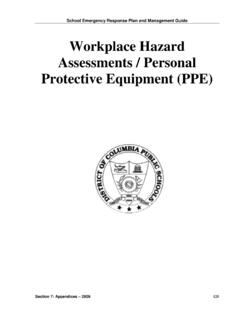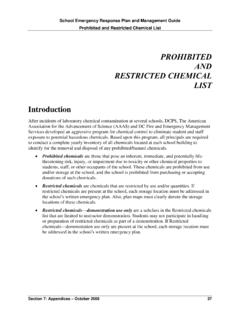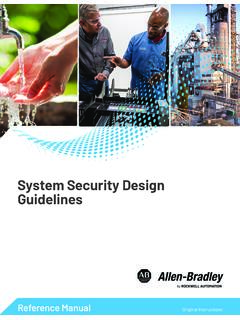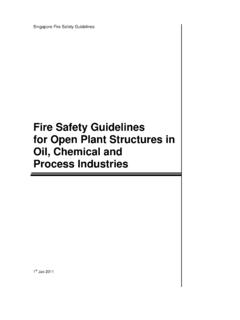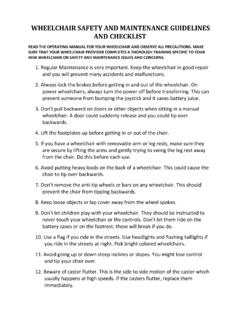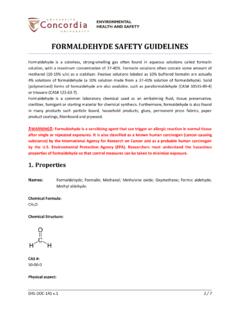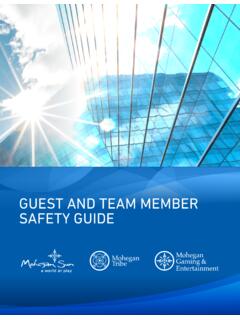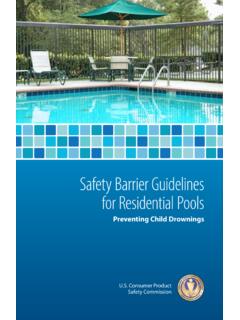Transcription of Fire and Life Safety Guidelines for Schools
1 PR E VE NT I ON PR OT OCOL Fire and Life Safety Guidelines for Schools1 Depending on Assistance Needed, Call: OPEFM Safety Unit 202 576 8962 Fire & EMS Department 202 727 1600 OPEFM Maintenance Customer Service 202 576 7676 LEA Contact Other Situation Description Prevention is the key to eliminating the conditions that may contribute to the cause of any fire or loss of life. Apart from arson, major causes of school fires include improper handling and storage of flammable liquids, overloaded electrical outlets, and excessive cumulative combustible materials. The Office of Public Education Facilities Modernization (OPEFM), Safety , Regulatory and Environmental Compliance Section, in collaboration with the DC Fire Marshal s Office, has developed the following compilation to assist school administrators and personnel responsible for the daily maintenance of physical facilities in Schools . It includes building features, maintenance, and operational requirements from the International Fire Code (IFC) and applicable National Fire Protection Association (NFPA) standards.
2 Maintenance of means of egress Principals and teachers must inspect all exit facilities daily in order to make sure that all stairways, doors, and other exits are in proper condition. Exit discharge areas and outside steps must be kept clear of snow, ice, or debris accumulations that could impede egresses. Exit doors must be easily opened from the side of egresses. Only one locking or latching device is permitted on any exit door. Locking devices that require the use of a key, tool, or special knowledge to open from the egress side of the door are strictly prohibited. 1 This Protocol contains information developed and implemented by District of Columbia Public Schools and can be used as a guideline for other District LEAs. Each LEA should review and edit the contents to conform to their procedures and contacts. Exit doors must never be chained, locked, slide-bolted or barred against an egress when a building is occupied.
3 (A building is considered to be occupied when 10 or more adults or one student is present in a facility.) Means of egress must be marked with illuminated signs except where locations of exits are otherwise obvious. Storage of any type is prohibited in a stairway. Clothing and personal effects must not be stored in hallways unless the building is protected by an automatic sprinkler system, the hallway is protected by a smoke detection system, or storage is in metal lockers. Combustible or flammable materials must not be placed, stored, or kept in any portion of an exit. Any fire door ( , stairwell door) that is designated to normally be kept closed (equipped with a self-closing mechanism) must not be blocked open. These doors may be equipped with a magnetic hold-open device if it releases the door automatically upon activation of smoke detectors, which are supervised by the building s fire alarm system.
4 Mirrors must not be placed in or adjacent to an exit in a way that would confuse the direction of egress. Draperies and similar hangings must not obscure an exit. Vending machines, display boards, signs, coat racks, and any other movable equipment that obstructs the path of egress travel is prohibited. Exit access corridors shall be not less than six feet clear width. Any penetrations through fire separation walls, ceilings, or floors must be sealed with an appropriate sealing compound or device. Ordinary caulking or duct seal are not acceptable for this purpose. Decorations and art work Student-prepared artwork and teaching materials may be attached directly to the walls and must not exceed 20 percent of wall areas. Draperies, curtains, and similar furnishings and decorations must be flame resistant and certified as passing the flame resistance testing of NFPA 701 and must not exceed 10 percent of wall and ceiling area.
5 Display of live or fresh-cut trees, even during the holiday season, is prohibited in all educational buildings. Noncombustible artificial trees may be displayed in locations that will not interfere with egress. General housekeeping Only items associated with operations of the boiler room and/or mechanical rooms should be stored in these areas. No combustible materials are to be stored in these areas. Storage areas and supply rooms must be kept neat and orderly. Empty cartons, old decorations, and other items should not be allowed to accumulate. Storage of these materials must be separated from heat sources. Note: Pallets are not required for storage of combustible materials/boxes or for keeping them off of the floor. Maintain storage height to 24 inches or more below the ceiling in nonsprinklered buildings, or a minimum of 18 inches below sprinkler head deflectors in sprinklered areas of the building.
6 All materials subject to slow oxidation ( , paint rags, wax rags, oil mops, etc.) should be stored in approved, closed metal containers until they can be either laundered or disposed of properly. Storage of flammable materials Volatile and flammable liquids (duplicating fluids, paints, paint thinners, oils, wax, gasoline, etc.) must be stored in approved containers. Use of these materials is prohibited in areas where there are open flames, electrical sparks, and running motors. Bulk storage of such materials must be in specified flammable-liquid storage rooms only. In the absence of such a special room, they must be stored in outside areas such as tractor storage rooms. Refer to the Classroom HAZMAT Storage Checklist to be utilized in Schools that is available for download at the ESA website: Storage of Fuel Powered Lawn Equipment Gasoline and diesel fuel powered lawn and garden equipment (including snow-blowers) is to be stored in an appropriate detached (outside) equipment storage building.
7 O Primary Alternative: Only, in the event outside storage facilities are not available on the school grounds a room in the school building that is designed with at least a 1-hour fire resistant rating and/or is protected by an automatic fire suppression system that has an access door leading directly to the outside without an entrance door into the building (these rooms are often referred to as can or can washing rooms and are usually located near the loading dock) can be used to store gasoline and diesel fuel powered lawn and garden equipment. o Secondary Alternative: Only if the previous two features do not exist in or on school property then a room with a self-closing, hour fire rated door leading into the school from a room that has at least a 1-hour fire resistant rating and that is protected by an automatic fire suppression system could be used to store gasoline and diesel fuel powered lawn and garden equipment.
8 The interior door must display a sign to indicate Equipment Storage and remain locked to prevent unauthorized access. Fuel Storage: In any of the storage solutions described above, fuel is to be stored in an approved 5 gallon (max size) metal Safety can (flammable liquids). Fuel inside the lawn equipments fuel tank should not be drained and is not to be included in this total. o Permit Required Fuel Storage: In the event that additional fuel storage is necessary (beyond 30 days) an operational permit is required to be obtained from the DC Fire Marshal s Office by the school administration. The cost of a yearly permit is $ Note: Even with a permit, gasoline in excess of 5 gallons must be stored in an approved flammable storage cabinet and cannot exceed 60 gallons. Fueling Equipment: The filling or removal of fuel in gas tanks (storage or equipment) inside school buildings is strictly prohibited.
9 All fueling operations are to be conducted outside of the building, in open air. Report any fuel spills immediately. Security: In any of the storage solutions described above, doors are to remain locked to prevent unauthorized access. The school emergency response plan must specify the location of the fuel and equipment storage. Fire extinguishers All portable fire extinguishers must be checked monthly for obvious damage, broken seals, and to ensure that the gauge is in the operable range or, if not equipped with a gauge, for the proper weight. School-based personnel are responsible for monthly inspection of fire extinguishers. Pressurized water extinguishers (or any other extinguisher that carries a 2-A rating) in hallways must be placed so that the travel distance to reach extinguisher is no more than 75 feet (distance between extinguishers cannot exceed 150 feet). All laboratories, shops, mechanical and boiler rooms, and other areas containing special hazards must have an extinguisher(s) rated for use with A, B, and C-type hazards.
10 Portable fire extinguishers must be installed in all kitchens and must be compatible with the automatic suppression system agent used in the hood suppression system. A thorough inspection by trained personnel, following maintenance procedures in NFPA 10, the Standard for Portable Fire Extinguishers, is required annually. Location of classrooms Rooms normally occupied by preschool, kindergarten, or first-grade pupils must not be located above or below the story of exit discharge. The story of exit discharge is that floor or stories of the building from which exits are primarily doors discharging directly outside, essentially at grade level. Where no such floor exists, the story of exit discharge must be that with the smallest elevation change needed to reach the level of exit discharge. Rooms normally occupied by second-grade pupils must not be more than one floor above the story of exit discharge.
